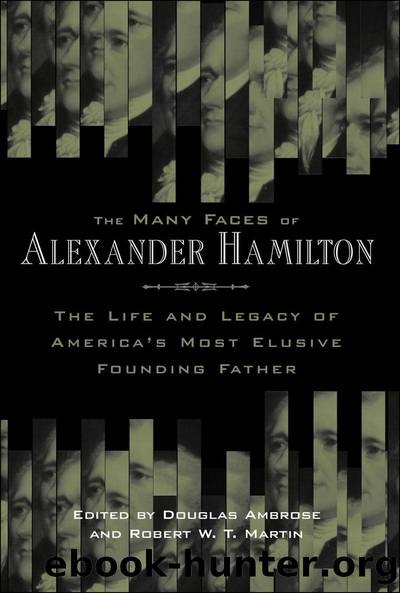The Many Faces of Alexander Hamilton by Douglas Ambrose Robert W. T. Martin

Author:Douglas Ambrose, Robert W. T. Martin [Douglas Ambrose, Robert W. T. Martin]
Language: eng
Format: epub
ISBN: 9780814707241
Barnesnoble:
Publisher: New York University Press
Published: 2007-09-01T00:00:00+00:00
NOTES
1. George W. Carey, The Federalist: Design for a Constitutional Republic (Urbana: University of Illinois Press, 1989); Robert Dahl, Preface to Democratic Theory (Chicago: University of Chicago Press, 1956); Gottfried Dietze, The Federalist: A Classic of Federalism and Free Government (Baltimore: Johns Hopkins University Press, 1960); David F. Epstein, The Political Theory of The Federalist (Chicago: University of Chicago Press, 1984); Albert Furtwangler, The Authority of Publius: A Reading of The Federalist Papers (Ithaca, NY: Cornell University Press, 1984); Charles Kesler, ed., Saving the Revolution: The Federalist Papers and the American Founding (New York: Free Press, 1987); Garry Wills, Explaining America: The Federalist (New York: Penguin Books, 1981); and Morton White, Philosophy, The Federalist, and the Constitution (New York: Oxford University Press, 1987).
2. On the frequently contradictory nature, if ânot outright inconsistencyâ of The Federalist, see Jack Rakove, âEarly Uses of The Federalist,ââ in Saving The Revolution, ed. Kesler, 238.
3. Gordon Wood, âThe Democratization of Mind in the American Revolution,â in The Moral Foundations of the American Republic, ed. Robert H. Horowitz, 3rd ed. (Charlottesville: University Press of Virginia, 1986), 123, 117.
4. See Daniel Walker Howe, âLanguage of Faculty Psychology in The Federalist Papers,â in Conceptual Change and the Constitution, ed. Terence Ball and J. G. A. Pocock (Lawrence: University Press of Kansas, 1988), 118.
5. See Howe, âLanguage of Faculty Psychology,â 127, and Bernard Bailyn, To Begin the World Anew (New York: Alfred A. Knopf, 2003), 108â9.
6. See Martin Diamond, âDemocracy and The Federalist A Reconsideration of the Framersâ Intent,â American Political Science Review 53 (Mar. 1959): 64, and George F. Will, Statecraft as Soulcraft: What Government Does (New York: Simon and Schuster, 1983), 43, who writes that with Publius âthe task of restraining and transforming the appetites is replaced by the task of directing them into useful, or at least not harmful, channels.â
7. Hamilton, âSpeech [22 June 1787],â in Max Farrand, ed., The Records of the Federal Convention of 1787, 4 vols., rev. ed. (New Haven: Yale University Press, 1937), 1: 376.
8. See Terence Ball, âA RepublicâIf You Can Keep It,â in Conceptual Change and the Constitution, ed. Terence Ball and J. G. A. Pocock (Lawrence: University Press of Kansas, 1988), 151â52; John T. Agresto, âLiberty, Virtue, and Republicanism: 1776â1787,â Review of Politics 39 (Oct. 1977): 473â504; David E. Narrett, âA Zeal for Liberty: The Anti-Federalist Case against the Constitution in New York,â in Essays on Liberty and Federalism: The Shaping of the U.S. Constitution, ed. David E. Narrett and Joyce S. Goldberg (College Station: University of Texas Press, 1988), 73; and Saul Cornell, The Other Founders: Anti-Federalism and the Dissenting Tradition in America, 1788â1828 (Chapel Hill: University of North Carolina Press, 1999).
9. I treat Hamilton and Madison as a collective author, Publius. In support, see George W. Carey, âPubliusâA Split Personality?â Review of Politics 46 (Jan. 1984): 18â19; Martin Diamond, âThe Federalistâs View of Federalism,â in Essays in Federalism, ed. George C. S. Benson (Claremont, CA: Institute for the Study of Federalism, 1961), 34; and Thomas S. Engeman, Edward J.
Download
This site does not store any files on its server. We only index and link to content provided by other sites. Please contact the content providers to delete copyright contents if any and email us, we'll remove relevant links or contents immediately.
Machine Learning at Scale with H2O by Gregory Keys | David Whiting(4179)
Never by Ken Follett(3790)
Harry Potter and the Goblet Of Fire by J.K. Rowling(3774)
Unfinished: A Memoir by Priyanka Chopra Jonas(3332)
Fairy Tale by Stephen King(3220)
The Man Who Died Twice by Richard Osman(2997)
Will by Will Smith(2792)
Rationality by Steven Pinker(2291)
The Dark Hours by Michael Connelly(2243)
Can't Hurt Me: Master Your Mind and Defy the Odds - Clean Edition by David Goggins(2227)
It Starts With Us (It Ends with Us #2) by Colleen Hoover(2198)
The Storyteller by Dave Grohl(2171)
The Dawn of Everything: A New History of Humanity by David Graeber & David Wengrow(2122)
Friends, Lovers, and the Big Terrible Thing by Matthew Perry(2119)
The Becoming by Nora Roberts(2087)
The Stranger in the Lifeboat by Mitch Albom(2050)
Cloud Cuckoo Land by Anthony Doerr(2034)
Einstein: His Life and Universe by Walter Isaacson(1967)
Love on the Brain by Ali Hazelwood(1965)
